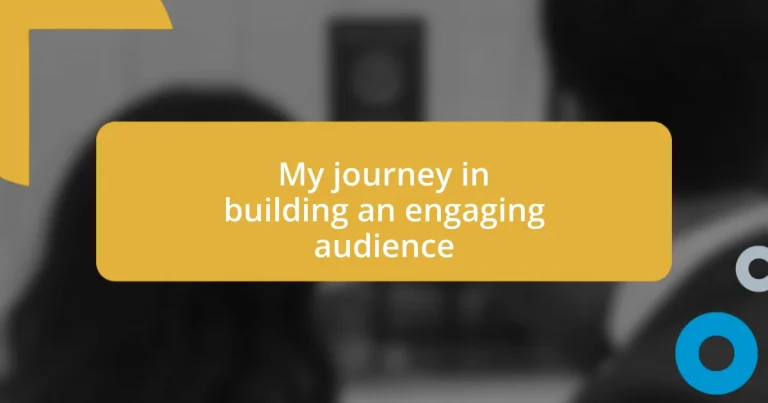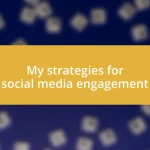Key takeaways:
- Engagement is about creating genuine connections with the audience, emphasizing active listening and sharing personal stories.
- Defining and understanding your target audience is crucial; deep research and interaction help tailor content that truly resonates.
- Utilizing feedback and adapting content based on audience preferences encourages loyalty and enriches community interaction.

Understanding audience engagement
Understanding audience engagement goes beyond just numbers and metrics; it’s about forming connections. I remember the first time I realized this during a live Q&A session. The energy in the room shifted the moment I acknowledged a member’s question directly. It was a small interaction, yet it created a ripple effect, encouraging others to share their thoughts. Isn’t it fascinating how a simple acknowledgment can spark deeper conversations?
Another aspect I’ve discovered is that emotional engagement plays a key role in keeping an audience invested. I once launched a campaign sharing my own struggles, and the response was overwhelming. People began opening up, sharing their stories in return. I found myself immersed in a community that was not just passive consumers of content but active participants in a shared journey. Can you recall a time when someone’s vulnerability inspired you to connect more authentically?
It’s essential to listen actively to your audience’s feedback; their insights are invaluable. Early on, I noticed that a particular topic sparked lively discussions, while another fell flat. Instead of feeling discouraged, I viewed it as a chance to pivot my content strategy. By embracing this feedback loop, I created a space where my audience felt heard and valued. How often do you engage with your audience to understand their needs?
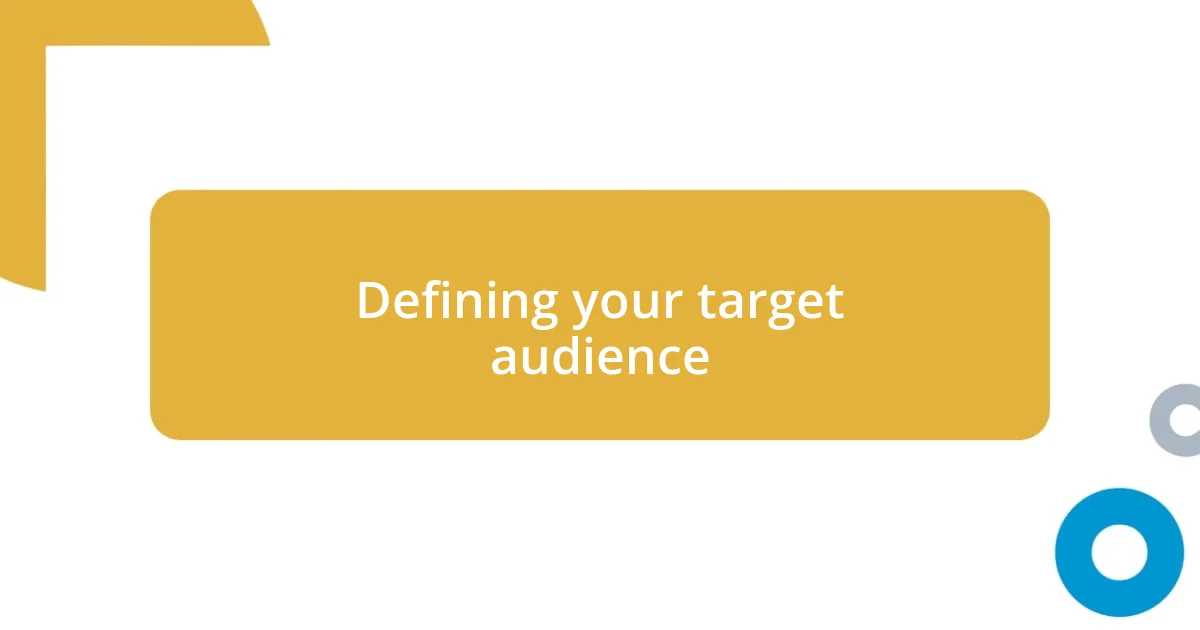
Defining your target audience
Defining your target audience is crucial because it shapes the direction of your content. I once spent weeks creating a series of videos aimed at a demographic I thought I understood, only to realize I had completely missed the mark. After conducting surveys and engaging directly with my followers, I discovered their interests and pain points were wildly different from what I had assumed. This experience underscored the importance of deep research and genuine interaction to get to know who you’re really trying to reach.
When defining your audience, consider these key aspects:
- Demographics: Age, gender, location, and income level can provide foundational insights.
- Interests and Behaviors: What topics resonate with them? What hobbies do they pursue?
- Challenges and Pain Points: Understanding their struggles helps you offer solutions that truly matter.
- Engagement Channels: Where do they hang out? Is it social media, forums, or newsletters?
By investing the time to know your audience on a deeper level, I found that my content became much more relatable and impactful. It’s a powerful realization that over time, if nurtured, these connections can transform a casual viewer into a loyal community member.
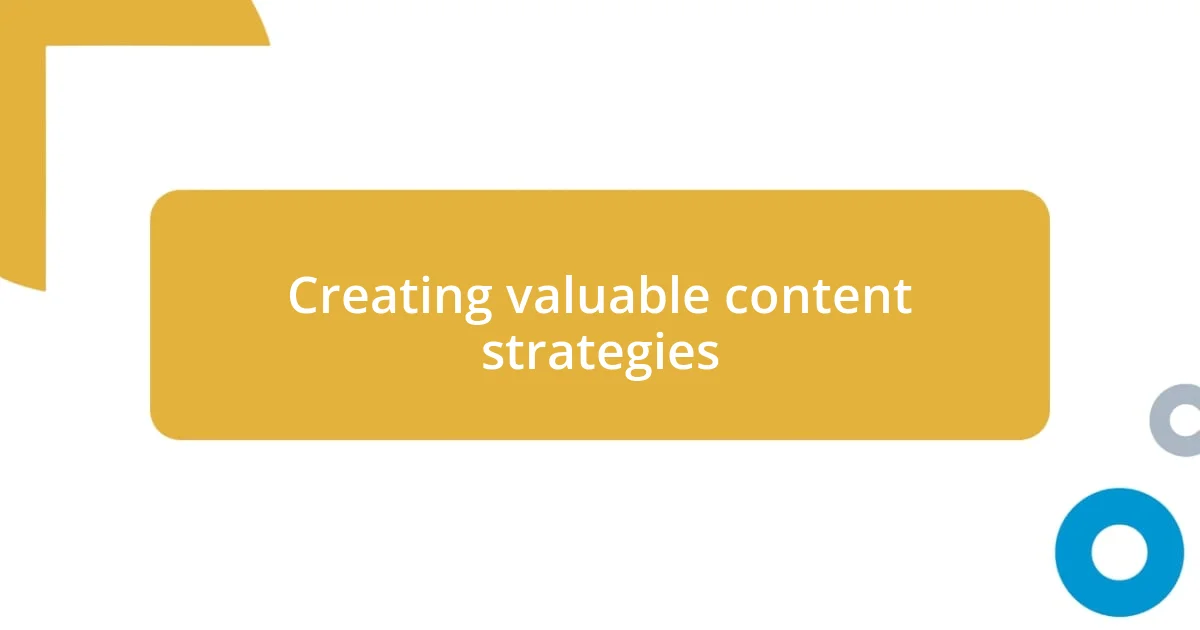
Creating valuable content strategies
Creating valuable content strategies is all about focusing on what will resonate deeply with your audience. I clearly remember the moment I decided to incorporate storytelling into my content. Rather than just presenting facts, I began sharing personal experiences and lessons learned. This shift made my audience feel like they were part of a narrative rather than just passive recipients of information. Have you ever felt a stronger connection to a piece of content because it told a story? That’s the magic of storytelling in engagement.
Moreover, consistency in posting was another game-changer for me. Initially, I was sporadic, sharing content when inspiration struck. However, when I established a regular schedule, my audience began to anticipate and engage more actively. There’s something comforting about knowing when to expect new content. It’s akin to building a routine in a friendship; the more reliable you are, the stronger the bond becomes. Have you noticed how your own habits change when you know something is reliably available?
Ultimately, utilizing diverse formats can also enhance your content strategy. I experimented with videos, infographics, and podcasts, each bringing a unique dimension to my messaging. It’s fascinating to see how different formats cater to various preferences within your audience. For instance, some followers thrived on visual content, while others sought out in-depth discussions. When I tailored my content to these preferences, engagement surged as people felt I was speaking directly to them. Have you tried mixing up your content formats to see what resonates with your followers?
| Content Strategy | Description |
|---|---|
| Storytelling | Using personal anecdotes to foster connection. |
| Consistency | Posting regularly to establish expectation. |
| Diverse Formats | Exploring videos, infographics, and podcasts. |

Utilizing social media effectively
Understanding how to utilize social media effectively has been a transformative journey for me. I vividly recall my initial days on platforms like Instagram and Twitter, where my posts barely received a glance. It wasn’t until I started leveraging insights from analytics tools that I saw significant changes. I realized that timing my posts to when my audience was most active led to higher engagement. Have you ever wondered why some posts go viral while others don’t? Finding that sweet spot can truly make all the difference.
Engagement goes beyond just posting; it’s about conversing with your audience. I learned the value of responding to comments and messages proactively. One time, a follower reached out with a thoughtful question, and taking the time to respond in detail not only strengthened our connection but also encouraged others to participate. Think about the last time someone acknowledged you online; didn’t it make you feel valued? When people feel heard, they are far more likely to stick around and engage.
Moreover, I discovered the power of using social media tools for promotion and collaboration. By joining forces with fellow creators, I tapped into new audiences that I wouldn’t have reached alone. Collaborations opened doors I didn’t even know existed. Isn’t it fascinating how a simple network can expand your reach exponentially? Sharing each other’s work not only showcased diverse perspectives but also reinforced a sense of community that made my journey feel even more rewarding.
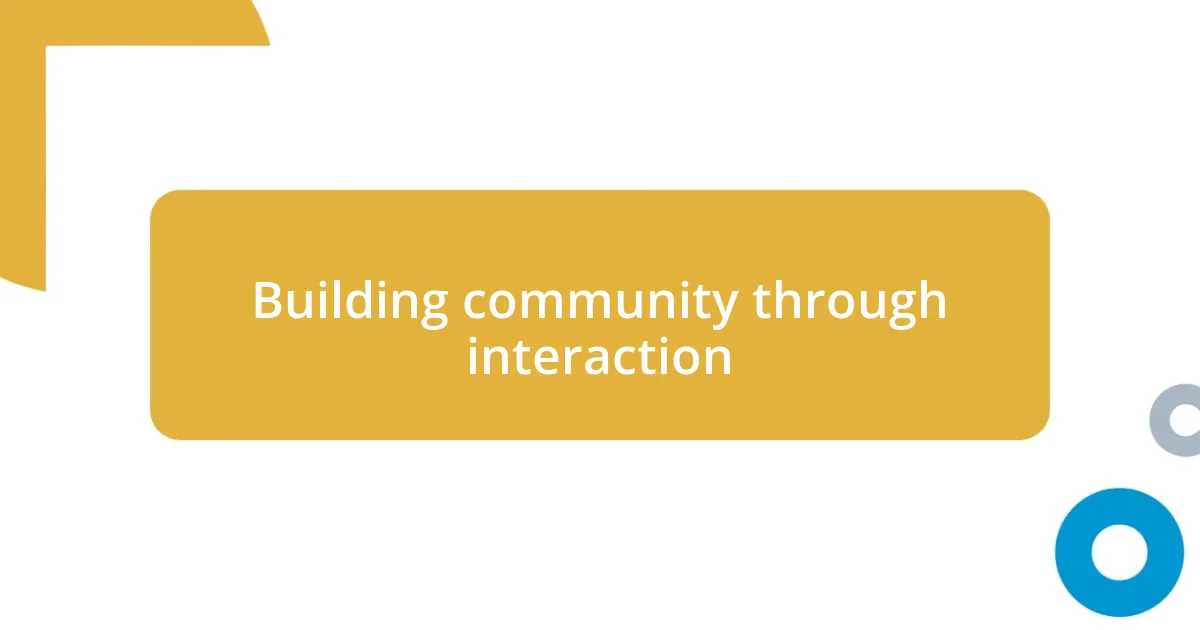
Building community through interaction
Building a community thrives on interaction, and I’ve seen this unfold through my own experiences. There was a time when I decided to host weekly Q&A sessions, inviting my followers to ask anything they wanted. It felt like opening my living room to friends, fostering a space where everyone could express themselves. Have you ever participated in a live session where your voice truly mattered? The excitement from those moments was palpable, sparking real conversations that not only informed but also inspired my community.
In another instance, I began implementing polls on my social media stories. The feedback was astonishing! I felt a rush of connection when my audience contributed their opinions. It was more than just numbers; it was about understanding their preferences and passions. Remember that feeling when someone values your input? That’s how I wanted my audience to feel—heard and appreciated. By actively involving them in decision-making, I transformed passive observers into engaged community members.
Sharing user-generated content has also been a pivotal strategy in strengthening my community. When I spotlighted a follower’s post or story—like when one person created art inspired by my content—I noticed an immediate boost in engagement. It wasn’t just about me anymore; it became a celebration of their creativity too. Don’t you love when your contributions are recognized publicly? This act of acknowledgment not only deepens bonds but also encourages others to share more, creating a vibrant tapestry of interactions within the community.
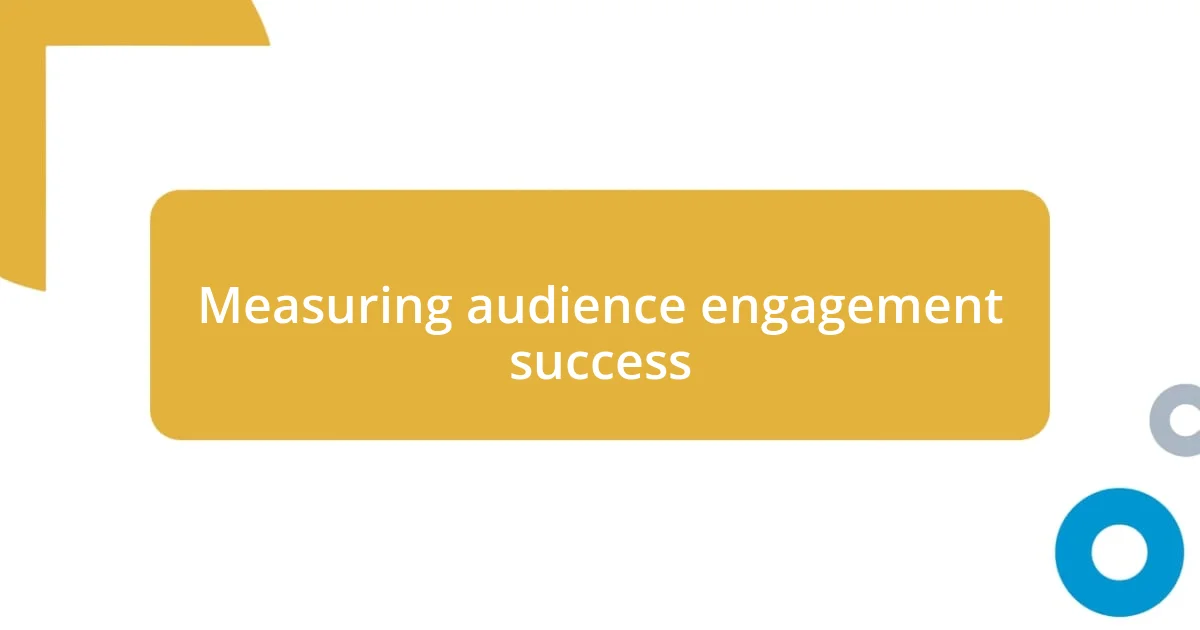
Measuring audience engagement success
Tracking audience engagement success requires a keen understanding of various metrics. For instance, during one of my campaigns, I focused on monitoring the number of shares and comments on my posts rather than just likes. The moment I noticed a spike in shares during a specific time of year, it clicked for me: Content that resonates deeply often gets shared more widely. Isn’t it exhilarating to see your ideas spread organically?
I also learned that diving into analytics can unveil patterns leading to engagement. After starting to analyze which content types performed best, I discovered that storytelling posts consistently garnered more interaction than standard information updates. I remember feeling a rush of excitement when I realized how much my audience craved connection through relatable narratives. It made me think—even outside social media, don’t we all appreciate a good story?
Finally, asking for feedback from my audience truly transformed my understanding of engagement success. One day, I sent out a simple survey asking what they liked most about my content. The insights were eye-opening! I felt a sense of connection when my followers expressed their preferences and desires. Wouldn’t it be amazing to shape your content based on direct input? This simple act not only promotes interaction but also fosters loyalty, as everyone loves to feel they have a stake in the conversation.

Adapting to audience feedback
Receiving feedback from my audience often feels like a breath of fresh air, opening my eyes to perspectives I hadn’t considered. For example, I once shared a post about a behind-the-scenes process I thought everyone would love. Surprisingly, I received comments suggesting they were more interested in what inspired the project instead. This feedback prompted me to pivot my future posts, focusing more on the backstory and emotions behind my work. Isn’t it fascinating how a simple comment can redirect your entire approach?
Beyond individual comments, I’ve also delved into more structured feedback, like hosting feedback forums tailored for my community. I vividly remember one session where a member courageously shared that they felt overwhelmed by the frequency of my posts. It was challenging to hear, but this insight helped me reevaluate my content schedule. I realized that quality truly outweighs quantity when it comes to keeping engagement high. Have you ever had to adjust your pace based on someone’s honest feedback? It’s a humbling experience that makes you appreciate the intricate dance of balancing input with your creative vision.
Moreover, I’ve started to celebrate the moments when feedback fuels innovation. During a recent content brainstorm, I invited my audience to share their dream topics. The excitement bubbled over as they contributed ideas, and one suggestion sparked a series of posts that ended up resonating deeply with my followers. What’s more rewarding than creating content that your audience actively wants to see? This collaborative approach doesn’t just build trust; it ensures that the content remains engaging and relevant to those who support it. Adapting to feedback is not just a response; it’s a vibrant conversation that thrives on mutual respect and creativity.












